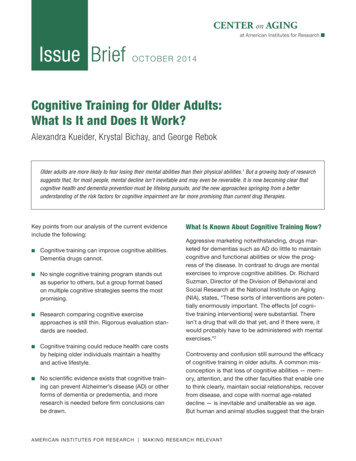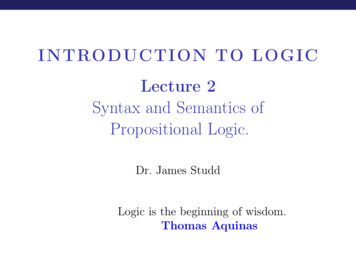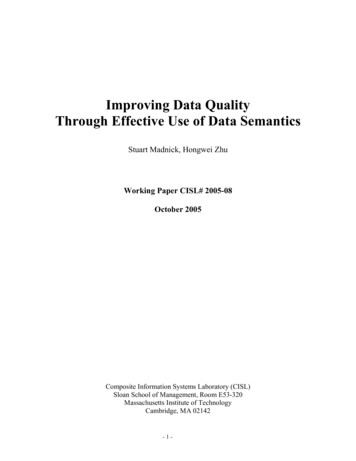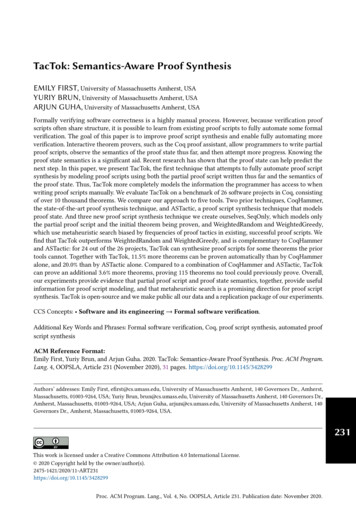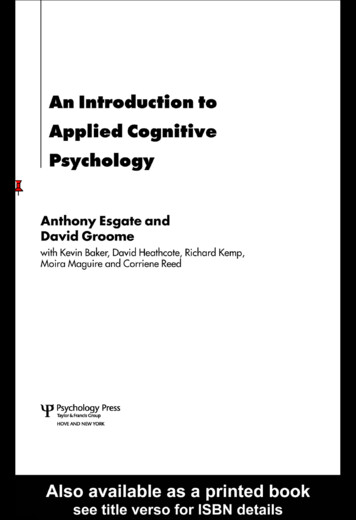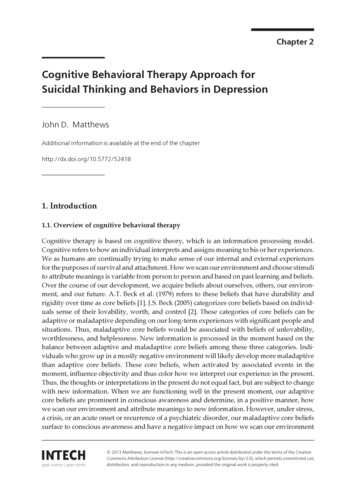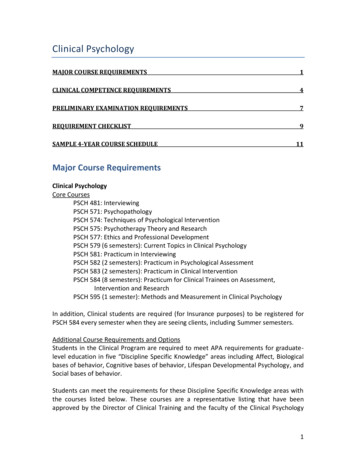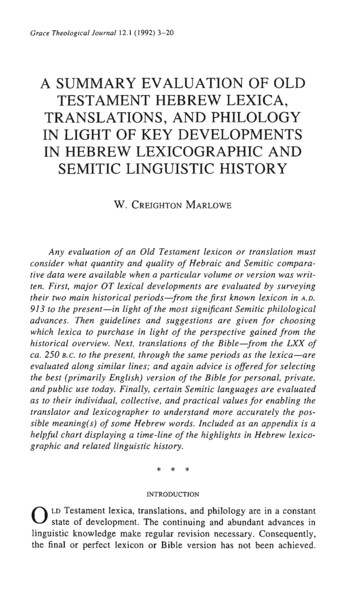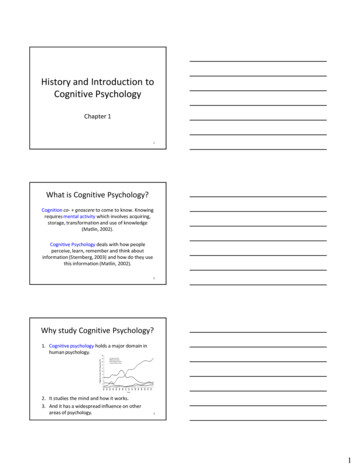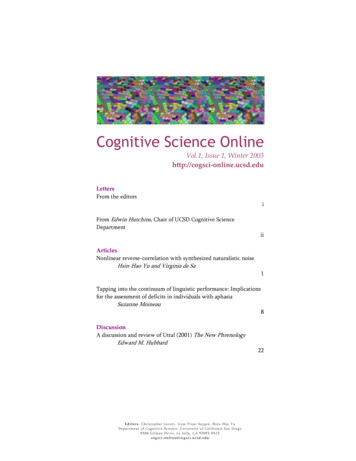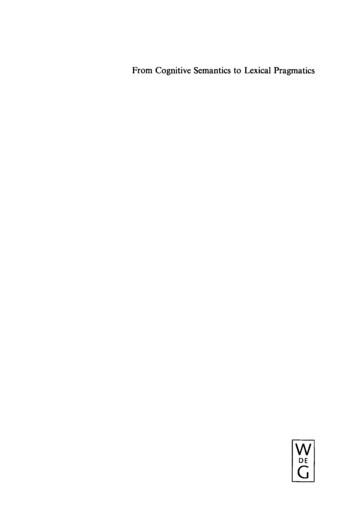
Transcription
From Cognitive Semantics to Lexical PragmaticsWGDE
From Cognitive Semanticsto Lexical PragmaticsThe Functional Polysemy of Discourse ParticlesbyKerstin FischerMouton de GruyterBerlin · New York 2000
Mouton de Gruyter (formerly Mouton, The Hague)is a Division of Walter de Gruyter GmbH & Co. KG, Berlin.Gedruckt mit Unterstützung der Deutschen Forschungsgemeinschaft. D 361 Printed on acid-free paper which falls within the guidelinesof the ANSI to ensure permanence and durability.Library of Congress Cataloging-in-Publication DataFischer, Kerstin, 1966—From cognitive semantics to lexical pragmatics : the functional polysemy of discourse particles / by Kerstin Fischer,p.cm.Includes bibliographical references and index.ISBN 3-11-016876-61. Discourse analysis. 2. Polysemy. 3. Pragmatics. I. Title.P302.F548 2000401'.41-dc2100-061631Die Deutsche Bibliothek -CIP-EinheitsaufnahmeFischer, KerstinFrom cognitive semantics to lexical pragmatics : the functionalpolysemy of discourse particles / by Kerstin Fischer. - Berlin ;New York : Mouton de Gruyter, 2000Zugl.: Bielefeld, Univ., Diss., 1998ISBN 3-11-016876-6 Copyright 2000 by Walter de Gruyter GmbH & Co. KG, D-10785 BerlinAll rights reserved, including those of translation into foreign languages. No part of this bookmay be reproduced in any form or by any means, electronic or mechanical, including photocopy, recording, or any information storage and retrieval system, without permission in writingfrom the publisher.Printing: Hubert & Co, Göttingen.Binding: Lüderitz & Bauer GmbH, Berlin.Printed in Germany.
AcknowledgementsThe main part of this work has been carried out within the graduateprogram 'task-oriented communication' at the University of Bielefeld,financially supported by the Deutsche Forschungsgemeinschaft, whichis gratefully acknowledged.There are many people who contributed to this study, in one wayor another. Most importantly, I want to thank Andreas Dommes, myfriends and my family for being with me during the hard times.Then there are my academic supervisors, Prof. Dr. Elisabeth Gülich,Prof. Dr. Hans Strohner, and Prof. Dr. Dafydd Gibbon. Furthermore, Igot much inspiration and encouragement from Prof. Charles Fillmoreand Prof. Paul Kay during my stay at UC Berkeley (made possibleby a research grant from the German Academic Exchange Service(DAAD)) and afterwards. I am also very grateful for the exciting discussions with Dr. Ulrich Dausenschön-Gay and Dr. Ulrich Krafft, andfor Prof. Dr. Helge Ritter's advice on artificial neural network classifiers.Finally, I would like to thank my colleagues in Bielefeld, Berkeleyand the Natural Language Systems group in Hamburg for their moral,technical, and academic support, and Dr. Christie Manning and Dr.Julie Berndsen for correcting my worst grammatical errors; however,I am solely responsible for any errors and inconsistencies that mayremain in the text.
Contents1Introduction: The domain11.1Aims11.2Definition131.2.1Semantic properties161.2.2Functional properties181.2.3Form-related properties231.31.41.52Corpora271.3.1The German corpora291.3.2The English corpora34Methods351.4.1Interpretative methods361.4.2Quantitative and computational methods . .551.4.3Linguistic models58The structure of the following60Contexts and categories: Functional interpretation652.1The functional spectrum of German ja682.2Category assignment972.2.199The descriptive inventory
viliContents2.2.22.33Consequences for lexical representation:Constructions110120Conceptual background frame:Evidence from extra-linguistic variables1253.1The variable communication partner1263.2The variable speaker's gender3.2.1 Äh and ähm in ion in artificial neural networks .Gender-related functional shifts in humancomputer interaction157166Consequences for lexical representation :Conceptual background frame1753.3.1The relation lexeme - function1763.3.2A frame of communicative domains . . . .178Lexical analysis1954.1Semantic relations1974.1.1Translation equivalents1994.1.2Semantic4.24.3fields207Semantic decomposition2194.2.1Methodological considerations2194.2.2Semantic tests for discourse particles . . .2234.2.3English oh2264.2.4Tests for the features of oh2324.2.5Further English discourse particles239Consequences for lexical representation:Invariant meanings258
Contents5Lexical representation5.1A unified model of the meanings and functionsof discourse particles5.1.15.36261261The contextual meanings of discourseparticles262From contextual meanings to discoursefunctions2705.1.3The different word classes2755.1.4The general function of discourse particles2775.1.25.2ixAspects of the lexicon2845.2.1General properties of linguistic léxica . . .2855.2.2The structure of lexical entries2895.2.3Types of lexical information2925.2.4Linguistic generalisations in ILEX/DATR .296A frame- and construction-based lexiconfor discourse particles300Conclusion and prospects3216.1From cognitive semantics to lexical pragmatics . .3216.2Automatic processing of discourse particles . . . .323References327Appendix A: Questionnaire357Appendix B: DATR Program359Index367
Chapter 1Introduction: The domain1.1AimsThis study concerns English and German discourse particles, smallitems such as German ja, also, ne, oh or ach and English yes, yeah, ohor well which predominantly occur in spontaneous spoken language.Discourse particles are "grammatically peripheral" (Fraser 1990: 391),that is, they do not enter any grammatical relationships with other partsof utterances, and they may fulfil such a broad range of functions thatHentschel and Weydt (1989) suggest the context-dependency of theirmeanings to be their most prominent feature, thus defining discourseparticles as essentially syncategorematic. The current investigationaddresses the problem of polysemy, "the occurrence of more-or-lessdiscrete and more-or-less unitary bundles of semantic properties associated with particular word forms" (Cruse 1992: 2); since the mostimportant contribution of discourse particles is in the pragmatic domain, particularly their functional polysemy, that is, the occurrence ofmore-or-less discrete and more-or-less unitary bundles of functionalproperties associated with particular word forms, will be investigated.In other words, this study attempts to account for the fact that a particular discourse particle lexeme may get different interpretations whichare perceived as related in some way. Consider the following examples:1The examples are from the Verbmobil corpus described in section 1.3.
2Introduction: The domain(1)13BAR: what about the 18th of December?14RIC: pause yeah, yeah, that work.(2)124ENG: so that won't work either.125UMI: yeah, that's not good.(3)1UMI: yeah, we've got to get together and discuss pause Stufe A für die Studienordnung.2(4)3RIC : I'm Rie and I am pause what do I do? (whispering) software . yeah, I'm working for a software account.The function of yeah in the first example is to accept the proposal thecommunication partner has made, it functions as a feedback signal inthe second example. In example (3), the function of yeah is to introduce a new topic, occurring in the first turn in the dialogue whichrefers to the common task to schedule an appointment. In example (4),it functions as a repair marker, reorganising the speaker's utterance after he was reminded of the identity assigned to him for the purpose ofthe recording (see the description of the corpora used in section 1.3).As the four examples show, yeah may fulfil at least four different functions. Thus, the questions that need to be answered in this investigationare the following:- What is the relationship between a discourse particle lexemesuch as yeah and its function as a feedback signal, an answerparticle, a topic signal and a repair marker?- Are the different readings of such a lexeme somehow related,i.e. is there some general mechanism behind its functional spectrum, or are the possible interpretations completely independentof each other?- Is there an invariant component in all of the occurrences of adiscourse particle lexeme?2The speakers in these dialogues are native speakers of English who live inGermany.
Aims3- Can each lexeme fulfil an endless range of functions or is therea systematic restriction to its functional spectrum?- What is the relationship between structural properties like theposition in which a discourse particle token occurs and its interpretation?- Is there a general mechanism for the interpretation of all discourse particles? Based on such a general mechanism is it possible to find criteria for a definition of the class?- How is it possible that lexical items which function as discourseparticles can often function in other word classes as well?The goal of this investigation is to find a general systematic modelof the polysemy of discourse particles, providing answers to the abovequestions and explaining not only how particular lexemes get theirfunctional interpretations in particular contexts but also what the essential properties of the word class of discourse particles are and howthis word class is related to other word classes. So far such a modelof the polysemy of discourse particles does not exist; Abraham (1991)criticises that all "descriptions given so far have, almost without exception, resulted in multiple meaning distinctions represented by onesingle phonetic form, without ever accounting for a common coremeaning and the conditions under which the variant meanings cometo hold" (Abraham 1991: 203). Hentschel and Weydt (1989) describethe current research situation as suffering from the so-called "particleparadox:" On the one hand there are approaches which provide detailed studies of the individual functions which discourse particles canfulfil, without being able to explain how a particular discourse particle gets its different interpretations, how these readings are related,and why it fulfils just exactly these pragmatic functions and not others. Most of these studies just list the different functions (for instance,Wolski 1986); this approach is also referred to as the maximalist approach (Mosegaard Hansen 1998: 239). On the other hand thereare analyses which try to isolate what is common to the readings of acertain lexeme, thus identifying an invariant component for each discourse particle. This perspective has been called the minimalist ap-
4Introduction: The domainproach (Mosegaard Hansen 1998: 240). These approaches leave openhow the abstract kernel meaning relates to the observable functionalinterpretations.Furthermore, most studies are restricted to a particular range offunctions and thus their complete functional spectrum does not become apparent.3 Very few are concerned with a general mechanismby means of which the discourse particle lexemes are related to theircomplete range of functions. These studies, among them most influentially Schiffrin (1987), but also Östman (1983), Mosegaard Hansen(1998) Ehlich (1986), and Schourup (1983)4 are however not enirelysatisfying. The former studis explain the functional polysemy of discourse particles by means of relations to different aspects of conversation, or "planes of talk" (Schiffrin 1987). Östman (1983) andMosegaard Hansen (1998) both use only three such aspects and cantherefore distinguish only three different functions of discourse particles, and in Schiffrin's model the relationship between the discourseparticle lexemes and the "planes of talk" is unclear (see also section 5.1and Redeker (1991) for a detailed analysis). The latter two approachesattempt to identify a general function of discourse particles from whichtheir other functions can be inferred. However, the fact that they arriveExamples are, for instance, the analysis of interjections as expressions ofemotions which neglects their textual functions (e.g. Angermeyer 1979);the very detailed study by Willkop (1988) which is restricted to functionswith respect to the speaker-hearer-exchange system and the argumentationstructure; or Maynard (1993) whose study focusses on aspects of subjectivity and emotionality. Jucker and Ziv (1998) write in their introduction to acollection of papers on discourse markers: "the first three papers ( . . . ) focus on text-structure signalling, the next set of papers ( . . . ) concentrate oncognitive aspects, and the remaining four papers ( . . . ) analyse contrastivemarkers, which display a range of attitudinal, cognitive and interactionalproperties, thus obviating the inherent problem of functional-domain specificity as criterial in the analysis" (Jucker and Ziv 1998: 5). Thus, even in thisnew book on the theory and description of discourse markers most studiesare restricted to a particular functional domain.These approaches are discussed in detail in section 5.1 when the model proposed in this investigation has been presented.
Aims5at completely different basic functions casts doubt on the plausibilityof the relationship proposed. Consequently, so far no unified accountof the range of the meanings and functions of discourse particles hasbeen presented; the aim is therefore to develop a lexical representationfor discourse particles which shows that there is a single mechanismwhich explains their functional polysemy and therefore also the characteristics of the word class.The problem just identified for the description of the word class under consideration is however a general problem; what has been labelledthe "particle paradox" holds for other word classes as well. The concept of polysemy, in contrast to homonymy, implies that the differentsenses of a single word form display a semantic relationship (Lyons1977).5 The task is not just to match a number of word forms witha list of possible functions but to ask whether it is possible to get beyond simple enumeration, as Pustejovsky (1995) calls it. Therefore notonly the meaning spectrum of each lexeme but also the conditioningfactors which determine its variation must be analysed. The analysisthus needs to focus on the conditions under which a lexeme may geta certain interpretation, and on how these factors interact in order toprovide a model of the interpretation of occurrences of the respectivelexical item.For other word classes, a number of accounts of the relations between the meanings associated with a certain lexeme have been proposed. Lyons (1977), for instance, discusses two ways of characterizing the relatedness of different word senses: historical developmentand shared semantic properties. With respect to both criteria he arguesthat they do not allow a categorical evaluation of relatedness since either may apply to different degrees. With respect to historical relatedness the question is how far back the analysis may go while still5The terms homonymy and polysemy furthermore both suggest that there areform-related properties which are constant while the functional or semanticfeatures vary. Discourse particles, however, are extremely variable in theirphonological and prosodie realisation, and their interpretation depends onthe structural contexts in which they occur. In how far discourse particlescan therefore be regarded as being formally stable and which realisationsconstitute a single lemma has to be considered in the investigation.
6Introduction: The domainyielding plausible results, that is, results which are in accordance withthe intuitive judgement of relatedness. Concerning the sharedness ofsemantic features the problem is likewise to identify the kind and number of shared properties necessary for the judgement of two meaningsas being similar. Thus, the closeness of senses basically remains amatter of intuitive decisions.More recently, further concepts to account for polysemy have beendeveloped. Pustejovsky and Anick (1988), Pustejovsky (1991, 1995)propose a systematic relationship between senses based on the different aspects of the qualia structure, the semantic properties of nouns.For instance, the qualia structure may account for the opposition between fast typist vs. fast driver, and for the event structure of verbs (forexample, bake a cake vs. bake a potato). The different aspects of thesemantic structure are incorporated into the semantic interpretation oflarger structures by means of rules of composition, including cocomposition and type coercion (Pustejovsky 1991: 437). The features employed in the description are not necessarily meant to be cognitivelyrelevant but are assumed if needed for semantic composition.The study of polysemy is also a central concern in cognitive linguistics, a number of different approaches to language which share "thecognitive commitment" (Taylor 1995: 4), the assumption that "language is a mental, i.e. cognitive phenomenon" (Taylor 1995: 4). Thiscommitment does not imply a particular research strategy itself, and sodifferent approaches can be subsumed under the term; for instance, intwo-level semantics (e.g. Bierwisch 1983, Bierwisch and Schreuder1992, Bierwisch and Lang 1989), which shares the cognitive commitment, an inventory of functions at the conceptual level is responsiblefor systematic polysemy. For example, words like school or universitymay mean the building, the institution, an ensemble of processes, orthe institution as a principle (Bierwisch 1983: 81). Depending on thecontext, the polysemy is determined by a general conceptual functionapplied to the abstract semantic meaning of each lexeme, yielding theconcrete reading, i.e. school as an institution or as a building. Therespective lexical item is seen as under-specified and unambiguous.Polysemy in this approach, which distinguishes sharply between semantic and encyclopedic knowledge, the two levels, is thus a matter ofworld knowledge.
Aims7An alternative cognitive linguistic research direction is the wholistic, non-modular, content-oriented approach (cf. Gibbs 1996) advocated by, for instance, Lakoff (1987), Langacker (1991), Fillmore(1982). This approach will be referred to as cognitive semantics in thefollowing. Initiated by findings from Rosch (1975), Rosch and Mervis(1975), Rosch et al. (1976), which indicate that natural language categories are not always based on necessary and sufficient criteria, thenotion of prototype was developed to account for the relationship between word senses (e.g. Coleman and Kay 1981, Wierzbicka 1989,Geeraerts et al. 1984). This distinguishes between the core and the periphery of concepts and may result in word senses which do not shareany essential properties at all (Lakoff 1987: 95). In network models(Langacker 1988, Norvig and Lakoff 1987), a central meaning for eachword can be identified to which other senses are related; these relations belong to an inventory of cognitively relevant operations, such asmetaphor, metonymy, profiling, etc. (Norvig and Lakoff 1987: 204).Lexical items thus exhibit radial structures (see also Lakoff 1987). Inthis variant of cognitive linguistics, word senses are thus not regardedto be similar because there are objective similarities between the objects denoted, but because of underlying conceptual structures, particularly métonymie and metaphorical relations (Lakoff and Johnson1980), which provide the links between the different readings (e.g.Lakoff 1987, Sweetser 1990: 5). Thus, "word meaning is not necessarily a group of objectively "same" events or entities; it is a groupof events or entities which our cognitive system links in appropriateways" (Sweetser 1990: 9). In Sweetser (1990), metaphorical mappingwas furthermore worked out to account for the polysemy and the historical development of English modals, conjunctions, and conditionals; by means of reference to three different conceptual domains, thepolysemy of the three different kinds of linguistic phenomena can beexplained.Another cognitive semantic approach is presented by Fillmore andAtkins (1992) according to whom polysemy is constituted by two different concepts and their interaction: "Frame semantics makes it possible to separate the notion of the conceptual underpinnings of a concept from the precise way in which the words anchored in them get
8Introduction: The domainused" (Fillmore and Atkins 1992: 101). They argue for a descriptionagainst a structured experiential background which constitutes a kindof conceptual prerequisite for understanding (cf. also Fillmore 1975,1982, 1994), and they consider the grammatical patterns of the particular item as a determining factor such that "the interrelations betweentwo notions: semantic frame and syntax" (Fillmore and Atkins 1992:101) must be specified to account for the relations between the sensesof a lexical item. Frame semantics consequently allows the descriptionof the interaction of the lexeme, syntax and a conceptual backgroundframe.Which model of polysemy is suitable for the description of the multifunctionality of discourse particles depends on what informationalresources are found to condition the interpretation of their occurrencesand how they interact. In this investigation, it will be argued that acognitive semantic viewpoint is the best starting point. While notdrawing on a priori distinctions between semantic and encyclopedicknowledge, as two-level semantics demands, cognitive semantic concepts such as metaphorical mapping and the reference to a conceptualbackground frame can explain the relationship between those factorswhich condition the interpretation of discourse particle occurrences.Furthermore, the inclusion of syntax in a model of polysemy, as inframe semantics, allows to consider the structural properties of discourse particles. This accounts for the fact that different discourseparticles may fulfil similar functions, on the one side, and restricts thegenerative component of the model to actual, lexicalized meanings onthe other. Thus, the functional polysemy of discourse particles canbe described by means of the interaction of their contextual propertiesand a conceptual background structure that is constituted by aspects ofthe communicative situation to which speakers attend regarding theircommunication partners. As a means of associating a discourse particle lexeme with the conceptual frame, the cognitive semantic conceptof metaphorical mapping between domains, as developed in Sweetser(1990), can be used to explain the reference of discourse particles tothe background structure. The development of such an approach tothe functional polysemy of discourse particles demands not only thatthe conditioning factors which are involved in the interpretation of dis-
Aims9course particle occurrences and their interaction are determined, it furthermore requires a device, such as the invariant contribution of therespective lexeme, which allows to show why one lexical item mayfulfil a certain function and not another. It also needs to show thatspeakers really attend to the conceptual background frame proposed,and it has to explain why just these particular domains are involved asopposed to some others, as well as to account for how these types ofinformation, which the hearer may use to interpret an occurrence ofa discourse particle, interact with the distributional patterning and thesurface features of the lexical item under consideration. For a lexicalpragmatic account of the functional polysemy of discourse particles ittherefore has to be determined:- what the functional spectrum of a discourse particle is and whatthe structural contexts are in which it may occur (chapter 2);- which domains determine the functional polysemy of the class(chapter 3);- what the contribution of each lexeme is (chapter 4);- how the different types of information interact and how the interaction can be formalised in a lexical representation (chapter5).An open question is thereby also the methodology for obtaining theinformation on the three interacting resources which condition the interpretation. Rather than adopting a particular linguistic methodology,this investigation will take a problem-oriented approach. It will propose methods to solve the problems occurring depending on the particular requirements for an explanatory account of the meanings andfunctions of discourse particles. So while the model to be developedwill be based on concepts developed in cognitive semantics, a numberof methodological questions will need to be addressed in the analysisof discourse particles and those factors which influence their interpretation. For instance, frame semantics has so far been predominantlyemployed for the description of nouns, verbs, and adjectives (Bakeret al. 1998: 86). Thus far it is not clear:
10Introduction: The domain- how the different readings of discourse particles can be distinguished;- what may constitute a frame for the interpretation of discourseparticles and how it can be identified;- how the invariant contribution of discourse particle lexemes canbe analysed.In this investigation methods will be proposed that can provide solutions to the methodological problems occurring, however, withoutcomparing the methods chosen to other methods in all possible detail.Thus, this investigation can exemplify a number of different methodsas solutions to particular problems, however, it cannot discuss all possible alternatives. The aim is instead to develop a methodologicallysound model of the functional polysemy of discourse particles whichis based on cognitive semantics concepts. In particular, it builds ona cognitive background structure to which the meanings of discourseparticles refer such that the interpretation of discourse particles in context is guided not only by their structural properties, but also by a groupof entities which are linked by our conceptual system in an appropriateway (Sweetser 1990: 9).Since this investigation aims at the lexical representation of a number of linguistic items, the perspective is furthermore semasiological.This study involves the lexical representation of the pragmatic behaviour of these lexical items in so far as it accounts for their use indiscourse on the basis of a number of partly new and partly well-testedmethods. Consequently, in contrast to previous analyses in the area oflexical pragmatics (e.g. Mercer 1992, Blutner et al. 1996, Lascaridesand Copestake 1995) which are primarily concerned with contextdependent and defeasible propositional information, the lexical pragmatic approach taken here concerns the distribution and the functionsof the items under consideration with respect to pragmatic domainssuch as the structure of discourse, face work, or the management ofspeech (see also Levinson 1983: pp.47-53) in which the functions ofdiscourse particles are located. The object domain is thus essentiallypragmatics while the concepts and methods to be employed will be
Aims11largely drawn from studies in cognitive semantics. One of the mainpoints of this investigation is thus that if the concepts developed incognitive semantics are applied to questions of lexical pragmatics, thatis, of the functional variation of certain lexical classes, a descriptivelyadequate model of the functional polysemy of discourse particles canbe developed.Such a model is desirable as there is so far no unified mechanism toaccount for the broad range of functions discourse particles fulfil hasbeen proposed. In spite of the many interesting properties of discourseparticles which have been discovered, researchers have so far failed toprovide a unified description of all of their functions. Thus there is nocomprehensive definition of the word class. It is also desirable becausediscourse particles display a quantitatively prominent status in spokenlanguage dialogues. For example, in the corpora from the toy-airplaneconstruction domain (Sagerer et al. 1994, Brindöpke et al. 1995), theproportion of discourse particles ranges between 3.8% in simulatedhuman-to-machine communication and 9.8% in informal human-tohuman communication. In particular the proportion of discourse particles of the 150 most common words is impressive (Fischer and Johanntokrax 1995: 6): Even in human-to-machine communication, theproportion of discourse particles amounts to 6.6% with respect to the150 most frequent words. Rudolph finds particles to constitute even23.8% of the total number of words in her corpora of German conversation, including however different types of particles, such as modal,scalar, focus, and discourse particles (Rudolph 1991: 208). As long asthere is no explanation of the functions of such particles in spoken language dialogues, we are lacking insight into almost 10% of speakers'linguistic efforts. Cognitive semantic approaches have so far focussedmainly on the relationship between linguistic structures and their cognitive motivation (see also Fischer 1999); the linguistic units underconsideration were thereby largely abstracted from particular usageevents. The motivation for this focus has been that while language usehas always been addressed under a functional perspective, linguisticstructures were for a long time considered as independent of other cognitive processes. The achievement of cognitive semantic and cognitivegrammar approaches to language is that they show that linguistic struc-
12Introduction: The domainture is also deeply related to general cognition. Applying a cognitivesemantic perspective on linguistic items such as discourse particles,which have their functions primarily in the pragmatic domain, bridgesthe gap between functional considerations developed in the analysis oftalk-in-interaction and the perspective on linguistic structures developed in cognitive aproaches to language. The result will be a lexicalmodel which represents the conventional aspects of discourse particlesand which can explain how these motivate the functions discourse particles may fulfil and how lexical and functional aspects interact. Thus,the model accounts for the relationship between the structured inventory of conventional
cussions with Dr. Ulrich Dausenschön-Gay and Dr. Ulrich Krafft, and for Prof. Dr. Helge Ritter's advice on artificia neural l network classi-fiers. Finally, I would like to thank my colleagues in Bielefeld, Berkeley and the Natural Language Systems group in Hamburg for their moral, technical, and academic support an, d Dr. Christi Mannine g .
